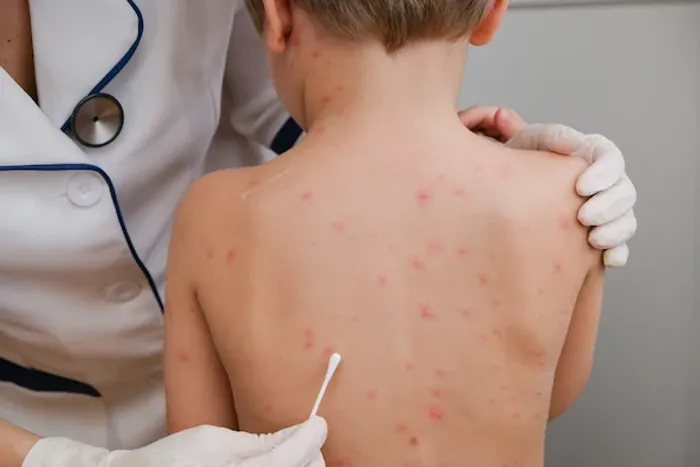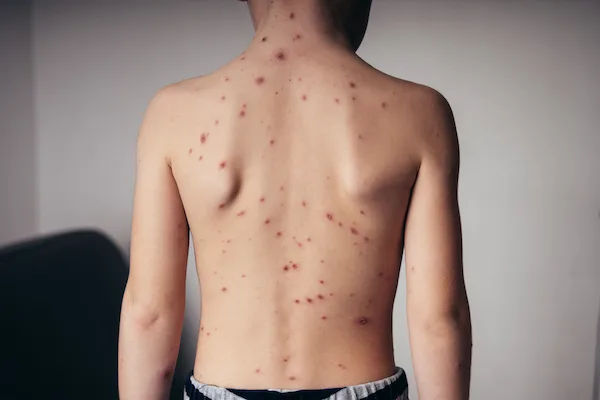Chickenpox: Causes, Symptoms, and How to Prevent It
Learn about chickenpox, including its causes, symptoms, complications, and prevention strategies such as vaccination and hygiene practices.


Introduction
Chickenpox, once a universal rite of childhood, is an incredibly contagious infection known for its signature itchy, blister-like rash. While often considered a mild illness, it can lead to serious complications, especially in infants, adults, and those with weakened immune systems. Understanding what causes the signs of chickenpox is the first step towards effective prevention and management. This highly infectious disease, caused by the varicella-zoster virus, spreads through the air with ease, making it a significant concern in schools and households. This comprehensive guide will walk you through the causes behind the symptoms, the typical progression of the infection, and, most importantly, the powerful preventive measures available today, including the highly effective chickenpox vaccine. By the end, you will be equipped with the knowledge to protect yourself and your family from this common yet preventable illness.
What Exactly is Chickenpox?
Chickenpox is an acute infectious disease caused by the varicella-zoster virus (VZV), a member of the herpesvirus family. Its hallmark is an itchy, blister-like rash that appears all over the body. Before the vaccine became widely available, nearly every person contracted chickenpox by adulthood. Today, thanks to immunisation, cases have dramatically declined.
The Virus Behind the Itch: Varicella-Zoster
The varicella-zoster virus is uniquely adapted to humans. After causing the initial chickenpox infection, the virus does not leave the body. Instead, it travels to nerve tissues near the spinal cord and brain, where it lies dormant. Years or even decades later, this same virus can reactivate, causing a painful condition called shingles (herpes zoster). This dual nature makes understanding and preventing the initial infection crucial for long-term health.
How Do You Catch Chickenpox? (Transmission)
Chickenpox is one of the most contagious diseases, spreading from person to person with remarkable efficiency. An infected person can spread the virus from 1 to 2 days before the rash even appears until all blisters have crusted over.
Direct Contact: The Primary Culprit
The most straightforward way the virus spreads is through direct contact with the fluid from the chickenpox blisters. Touching the rash and then touching your face or mouth, or touching contaminated objects like toys or bedding, can lead to infection.
Airborne Transmission: An Invisible Threat
This is the most common mode of transmission. When a person with chickenpox coughs, sneezes, or even talks, they release tiny droplets containing the virus into the air. These droplets can be inhaled by others nearby, leading to infection. This is why outbreaks can occur so quickly in classrooms or playgrounds.
The Stages and Signs of a Chickenpox Infection
The infection typically runs its course over 10 to 14 days, progressing through distinct stages.
The Initial (Prodromal) Stage: Before the Rash
Before the infamous rash appears, many people experience mild, flu-like symptoms. This prodromal phase usually lasts 1 to 2 days and includes:
- Fever (usually 101°–102°F)
- Fatigue and malaise (a general feeling of being unwell)
- Loss of appetite
- Headache
These early signs of chickenpox are often mistaken for a common cold, making the infected person unknowingly contagious.
The Active Stage: The Unfolding of the Rash
The classic chickenpox rash emerges in waves over several days. It often starts on the chest, back, and face before spreading everywhere else, including the scalp, mouth, eyelids, and genitals. The rash is intensely itchy and goes through three phases simultaneously on the body:
- Raised pink or red bumps (papules)
- Small fluid-filled blisters (vesicles)
- Crusts and scabs
The Evolution of Chickenpox Blisters
The transformation from a red bump to a scab typically takes about 24-48 hours. New waves of bumps continue to appear for 3-5 days. Therefore, a person may have all three stages of the rash at the same time. The total number of blisters can range from just a few to hundreds.
Who is Most at Risk for Severe Symptoms?
While most healthy children experience a mild case, certain groups are at higher risk for severe disease and complications:
- Infants under one year old
- Adolescents and adults
- Pregnant women (which also risks the foetus)
- Immunocompromised individuals (e.g., those with cancer, HIV, or on chemotherapy/steroids)
Potential Complications of Chickenpox
Although often mild, chickenpox can lead to severe complications that require hospitalisation.
Common Complications in Various Age Groups
- Bacterial infections of the skin and soft tissues from scratching the blisters.
- Pneumonia (lung infection), which is a leading cause of chickenpox-related death in adults.
Encephalitis (inflammation of the brain). - Dehydration from fever and poor fluid intake.
- Sepsis (a life-threatening bloodstream infection).
Long-Term Risk: Shingles (Herpes Zoster)
Anyone who has had chickenpox is at risk for shingles later in life. When the dormant VZV reactivates, it causes a painful, blistering rash usually limited to one side of the body. The risk increases with age or a declining immune system. The chickenpox vaccine significantly reduces the risk of later developing shingles.
Consult a Specialist for the best advice
How is Chickenpox Diagnosed?
Doctors can almost always diagnose chickenpox based on the distinctive rash. For atypical cases or to confirm the diagnosis, they may use lab tests on blood or a sample from a blister to look for the VZV virus. If you suspect you or your child has chickenpox, especially with a high fever or a widespread rash, consult a doctor online with Apollo24|7 for a quick evaluation and guidance.
The Most Effective Prevention Strategy: Vaccination
The single best way to prevent chickenpox is through vaccination. The chickenpox vaccine is a safe and highly effective tool that protects individuals and creates herd immunity in the community.
The Chickenpox Vaccine Schedule
The CDC recommends two doses of the varicella vaccine:
- First dose: 12 through 15 months of age
- Second dose: 4 through 6 years of age
Older children, adolescents, and adults who have never had chickenpox or been vaccinated should also receive two catch-up doses.
How Well Does the Vaccine Work?
Two doses of the vaccine are about 90% effective at preventing chickenpox entirely. For the small percentage of vaccinated people who still get chickenpox, they usually experience a much milder case with fewer blisters, little to no fever, and a faster recovery. This is known as "breakthrough chickenpox."
Additional Prevention Tips for Households and Communities
Beyond vaccination, simple measures can help contain the spread.
Isolation and Quarantine Measures
An infected person should stay home from work, school, or public places until all blisters have scabbed over, usually about 5-7 days after the rash first appears. They should also avoid contact with high-risk individuals.
Hygiene Practices to Limit Spread
- Wash hands frequently with soap and water.
- Avoid touching or scratching the rash.
- Clean and disinfect surfaces and objects that may be contaminated.
- Keep fingernails trimmed short to minimise skin damage from scratching.
Managing Symptoms and Providing Care at Home
There is no cure for chickenpox; treatment focuses on relieving symptoms until the immune system clears the virus.
Soothing the Itch and Discomfort
- Calamine lotion: Apply to blisters to soothe itching.
- Colloidal oatmeal baths: Soak in cool or lukewarm water for 20-30 minutes.
- Comfortable clothing: Wear loose, soft, cotton clothing to avoid irritating the rash.
- Hydration: Drink plenty of fluids to prevent dehydration.
Medications: What to Use and What to Avoid
- Fever Reducers: Use paracetamol for fever and pain. Crucially, avoid aspirin in children and teenagers, as it is linked to Reye's syndrome, a rare but serious condition.
- Antivirals: For high-risk groups or severe cases, a doctor may prescribe antiviral drugs like aciclovir to lessen the severity and shorten the duration of the illness.
When to Seek Professional Medical Help
While most cases can be managed at home, certain red flags require immediate medical attention. Contact a doctor if the infected person:
- Has a fever that lasts more than 4 days or rises above 102°F.
- Has a rash that becomes very red, warm, or tender (signs of a bacterial skin infection).
- Shows signs of dehydration (e.g., dizziness, decreased urination, dry mouth).
- Experiences difficulty waking up, confusion, or severe headache.
- Has difficulty breathing or a severe cough.
If any of these severe symptoms of chickenpox appear, book a physical visit to a doctor with Apollo24|7 immediately for urgent care.
Conclusion
Chickenpox, caused by the varicella-zoster virus, is far more than just a childhood itch. Its highly contagious nature and potential for serious complications, especially in vulnerable populations, make it a significant public health concern. The journey from the initial fever to the crusting of the final blister can be uncomfortable and disruptive. However, we are fortunate to live in an era with a powerful tool for prevention: the chickenpox vaccine. By understanding the causes and signs of this infection, practising good hygiene, and most importantly, ensuring vaccination for yourself and your family, you can effectively shield your loved ones from this disease. Taking these proactive steps not only prevents the immediate misery of chickenpox but also reduces the long-term risk of shingles, contributing to a healthier life for all.
Consult a Specialist for the best advice
Consult a Specialist for the best advice

Dr Syed Mateen Pasha
General Physician
2 Years • MBBS
Bengaluru
PRESTIGE SHANTHINIKETAN - SOCIETY CLINIC, Bengaluru

Dr. Anand Ravi
General Physician
2 Years • MBBS
Bengaluru
PRESTIGE SHANTHINIKETAN - SOCIETY CLINIC, Bengaluru

Dr. Syed Ismail Ali
General Practitioner
7 Years • MBBS
Hyderabad
Apollo 24|7 Clinic, Hyderabad
Dr. Karanam Kondalamma
General Practitioner
4 Years • MBBS
Hyderabad
KK Clinic, Hyderabad

Dr. Johnson. S
General Practitioner
7 Years • MBBS MD(Preventive and social Medicine)
Pune
Apollo Clinic, Nigdi, Pune
Consult a Specialist for the best advice

Dr Syed Mateen Pasha
General Physician
2 Years • MBBS
Bengaluru
PRESTIGE SHANTHINIKETAN - SOCIETY CLINIC, Bengaluru

Dr. Anand Ravi
General Physician
2 Years • MBBS
Bengaluru
PRESTIGE SHANTHINIKETAN - SOCIETY CLINIC, Bengaluru

Dr. Syed Ismail Ali
General Practitioner
7 Years • MBBS
Hyderabad
Apollo 24|7 Clinic, Hyderabad
Dr. Karanam Kondalamma
General Practitioner
4 Years • MBBS
Hyderabad
KK Clinic, Hyderabad

Dr. Johnson. S
General Practitioner
7 Years • MBBS MD(Preventive and social Medicine)
Pune
Apollo Clinic, Nigdi, Pune
More articles from Chickenpox Treatment
Frequently Asked Questions
Can you get chickenpox twice?
It is extremely rare to get chickenpox twice. After an infection, the body typically develops lifelong immunity. However, the virus remains dormant and can reactivate later in life as shingles.
How long is the chickenpox incubation period?
The incubation period—the time from exposure to the virus until symptoms appear—is typically 10 to 21 days. This long window makes it challenging to control outbreaks.
What’s the difference between chickenpox and hand, foot, and mouth disease?
While both cause rashes and blisters, they are caused by different viruses. Hand, foot, and mouth disease blisters are typically smaller and concentrated on the hands, feet, and inside the mouth, while chickenpox blisters are widespread and more itchy.
Are there any natural remedies for chickenpox itch?
Yes, besides oatmeal baths and calamine lotion, applying a cool, wet compress to the affected areas can provide relief. It is also vital to keep the skin cool, as heat and sweat can worsen itching.
Is the chickenpox vaccine safe?
Yes, the chickenpox vaccine is very safe. Most side effects are mild, such as soreness at the injection site, a mild rash, or a low-grade fever. The benefits of preventing chickenpox and its potential serious complications far outweigh the minimal risks.
